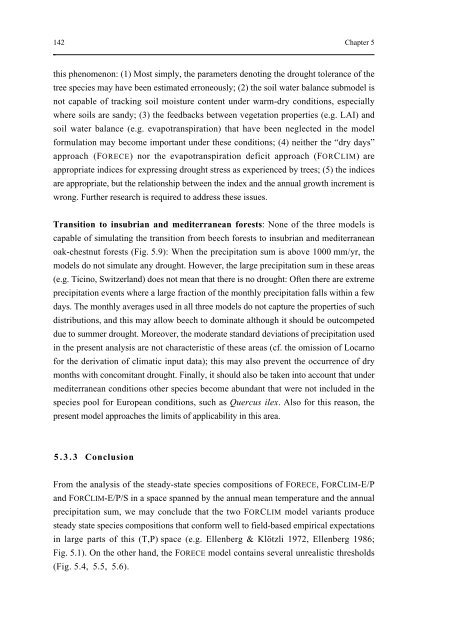On the Ecology of Mountainous Forests in a Changing Climate: A ...
On the Ecology of Mountainous Forests in a Changing Climate: A ...
On the Ecology of Mountainous Forests in a Changing Climate: A ...
You also want an ePaper? Increase the reach of your titles
YUMPU automatically turns print PDFs into web optimized ePapers that Google loves.
142 Chapter 5<br />
this phenomenon: (1) Most simply, <strong>the</strong> parameters denot<strong>in</strong>g <strong>the</strong> drought tolerance <strong>of</strong> <strong>the</strong><br />
tree species may have been estimated erroneously; (2) <strong>the</strong> soil water balance submodel is<br />
not capable <strong>of</strong> track<strong>in</strong>g soil moisture content under warm-dry conditions, especially<br />
where soils are sandy; (3) <strong>the</strong> feedbacks between vegetation properties (e.g. LAI) and<br />
soil water balance (e.g. evapotranspiration) that have been neglected <strong>in</strong> <strong>the</strong> model<br />
formulation may become important under <strong>the</strong>se conditions; (4) nei<strong>the</strong>r <strong>the</strong> “dry days”<br />
approach (FORECE) nor <strong>the</strong> evapotranspiration deficit approach (FORCLIM) are<br />
appropriate <strong>in</strong>dices for express<strong>in</strong>g drought stress as experienced by trees; (5) <strong>the</strong> <strong>in</strong>dices<br />
are appropriate, but <strong>the</strong> relationship between <strong>the</strong> <strong>in</strong>dex and <strong>the</strong> annual growth <strong>in</strong>crement is<br />
wrong. Fur<strong>the</strong>r research is required to address <strong>the</strong>se issues.<br />
Transition to <strong>in</strong>subrian and mediterranean forests: None <strong>of</strong> <strong>the</strong> three models is<br />
capable <strong>of</strong> simulat<strong>in</strong>g <strong>the</strong> transition from beech forests to <strong>in</strong>subrian and mediterranean<br />
oak-chestnut forests (Fig. 5.9): When <strong>the</strong> precipitation sum is above 1000 mm/yr, <strong>the</strong><br />
models do not simulate any drought. However, <strong>the</strong> large precipitation sum <strong>in</strong> <strong>the</strong>se areas<br />
(e.g. Tic<strong>in</strong>o, Switzerland) does not mean that <strong>the</strong>re is no drought: Often <strong>the</strong>re are extreme<br />
precipitation events where a large fraction <strong>of</strong> <strong>the</strong> monthly precipitation falls with<strong>in</strong> a few<br />
days. The monthly averages used <strong>in</strong> all three models do not capture <strong>the</strong> properties <strong>of</strong> such<br />
distributions, and this may allow beech to dom<strong>in</strong>ate although it should be outcompeted<br />
due to summer drought. Moreover, <strong>the</strong> moderate standard deviations <strong>of</strong> precipitation used<br />
<strong>in</strong> <strong>the</strong> present analysis are not characteristic <strong>of</strong> <strong>the</strong>se areas (cf. <strong>the</strong> omission <strong>of</strong> Locarno<br />
for <strong>the</strong> derivation <strong>of</strong> climatic <strong>in</strong>put data); this may also prevent <strong>the</strong> occurrence <strong>of</strong> dry<br />
months with concomitant drought. F<strong>in</strong>ally, it should also be taken <strong>in</strong>to account that under<br />
mediterranean conditions o<strong>the</strong>r species become abundant that were not <strong>in</strong>cluded <strong>in</strong> <strong>the</strong><br />
species pool for European conditions, such as Quercus ilex. Also for this reason, <strong>the</strong><br />
present model approaches <strong>the</strong> limits <strong>of</strong> applicability <strong>in</strong> this area.<br />
5.3.3 Conclusion<br />
From <strong>the</strong> analysis <strong>of</strong> <strong>the</strong> steady-state species compositions <strong>of</strong> FORECE, FORCLIM-E/P<br />
and FORCLIM-E/P/S <strong>in</strong> a space spanned by <strong>the</strong> annual mean temperature and <strong>the</strong> annual<br />
precipitation sum, we may conclude that <strong>the</strong> two FORCLIM model variants produce<br />
steady state species compositions that conform well to field-based empirical expectations<br />
<strong>in</strong> large parts <strong>of</strong> this (T,P) space (e.g. Ellenberg & Klötzli 1972, Ellenberg 1986;<br />
Fig. 5.1). <strong>On</strong> <strong>the</strong> o<strong>the</strong>r hand, <strong>the</strong> FORECE model conta<strong>in</strong>s several unrealistic thresholds<br />
(Fig. 5.4, 5.5, 5.6).















